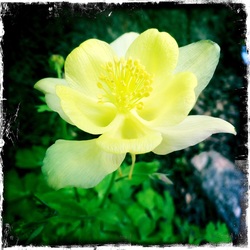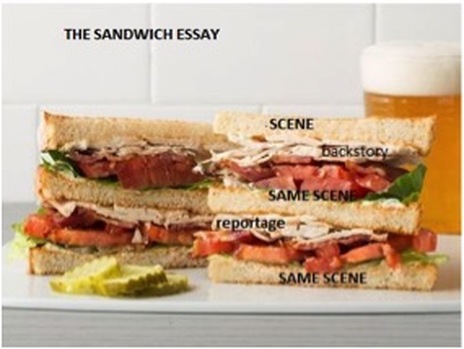ASSAY: A JOURNAL OF NONFICTION STUDIES
2.1
2.1
4. The Allusion (AMS)When I taught composition in the early 1990s, the comp director always encouraged us to talk to students about joining “the larger conversation.” The students didn’t know what the hell that meant. I’m not sure I knew what the hell that meant. But, over time, sitting alone writing essays at my desk, I learned that, in large part, my audience consists of all the readers and writers in my head, and sometimes I want to bounce my ideas off something they already know, like a backboard. So it was that a couple decades after teaching composition, I found myself trying to explain the “larger conversation” to MFA students, urging them to make an allusion, any allusion, because their essays were beginning to seem a little insular, verging on solipsistic. The students looked skeptical, so I combed through my books and found that, for example, in Best American Essays 2013, 20 of 26 essays discuss some object of culture: books, most often, or articles or movies, sometimes a TV show or a pop song. Still, when I suggested “the allusion” to Steve Harvey as one of these ten essay parts, he said something appropriately humble like “why don’t you do that one, since I don’t quite get it.” But he does get it! Every example you see below comes from his work. The first two come from his terrific collection A Geometry of Lilies.
Allusions can be illustrations of a larger idea. In “Kid Talk,” an essay about how kids are fearless verbal innovators, Steve references Theodore Roethke, Richard Rodriguez, and Henry David Thoreau, among others. What’s great about these allusions is they’re infused, like the best of allusions, with commentary and personality. Here’s one: “Kid talk survives the condescension of Art Linkletter, the intellectualizing of Lewis Carroll…” (Harvey 22). Later, when discussing Thoreau, he admits, “Some of my favorite [writers] have lost all but a trace of kid-talking eloquence” (Harvey 27). He goes on from there to describe the trace that remains. A single allusion can be the subject of an essay, the one backboard that all ideas get bounced off. “Endless Imitation” centers on the play Annie, which Steve’s daughter is acting in. The essay is not actually about Annie, it’s about one nuclear family, and in some ways, nothing can be more insular than that, but the allusion lets everyone in who’s ever seen the play or movie… even people like me who can’t stand Annie. An allusion can provide the framework for an essay. In the “The Book of Knowledge”—which first appeared in River Teeth and later in Best American Essays--Steve uses The Book of Knowledge, itself, this ten volume set of encyclopedia-type books he had as a kid, filled with questions about the world and their answers, as a frame for exploring what’s unknown, unknowable, even unfathomable. Perhaps the single most vexing question for essayists considering making allusions is: What about allusions readers may not get? References that are too time-sensitive or too esoteric, too pop culture or too high culture? Is it okay to use them? I say yes. Sort of. In “Frame of Reference,” a recent piece for The New Yorker, John McPhee urges “durability” in allusions, but admits that even that definition is shifty. A better solution is good writing, he concludes. If you, for example, describe someone as looking “like Tom Cruise,” McPhee argues that you’re asking Tom Cruise to do your writing for you, but if you describe the person vividly, with concrete details, then toss in the Tom Cruise bit as in the punchline, well, okay. Roxane Gay has made a career of addressing very time-sensitive topics from reality TV to the Sandusky scandal with timeless arguments. Will people still read her work years from now? I hope so. I believe so. 5. The Dialogue (SH)I am Socratic enough to believe that learning happens in dialogue, not monologue. Other voices offer new words that open up possibilities for meaning for us. I think of the smart aleck at the back of the class whose hand shoots into the air, and the way we in the class turn to that hand expectantly. If the lecture is long enough that interruption is always welcome. What is an interruption but another word for a breakthrough.
Here’s an example from Bernard Cooper’s essay about his father called “The Wind Did It.” At this point in the essay Cooper tells us that his father has read Secrets of the Maya five times and longs to travel to Machu Picchu with Bernard. Let me begin with a little bit of Cooper’s voice: [T]onight over dinner at Art’s Prime Rib, I ask my father if he would try to articulate just what it is about this particular civilization that intrigues him. For a moment he appears not to hear me and continues to blow on a spoonful of soup. Then he looks up. Thick glasses magnify his eyes. He pushes his French onion soup aside, places his palms on the table. (50) This is the voice of the essayist, precise, thoughtful, the voice of complete sentences. It uses words like “articulate” and draws pictures with details we see but often take for granted such as the thick glasses that magnify his father’s eyes. It names names: “French onion soup”; it appeals to several senses: “blow on a spoonful of soup.” Lovely as it is though, it cries out for another voice. Enter Bernard’s father, trying to answer his son’s question about the appeal of the Mayans:
“First of all,” he says, “they worshiped everything there was to worship, like, um, corn. . .” He drums his fingers, stumped. “You know—things. . . buildings. And they made contributions to the societies of today, like x-ray.” This is definitely a breakthrough, one that raises the crucial issue in the essay: our inarticulateness in the face of “unanswered questions” in a voice that ranges from “x-rays” to “Boychik” with an “um” thrown in. Dialogue offers relief from the author’s authoritative voice. When a lone voice is compelling—even mesmerizing as it can be with so many writers--an interruption is sometimes the only way for inarticulate truths to come crashing in.
|
6. The Echo (AMS)
We all know from studying literature to look for the reappearance of an object or image, one that represents a theme or a motif. But here I’m speaking more plainly, about repetition of a phrase or a snip of dialogue or sometimes a single word. Sometimes a word is repeated and gains new meaning each time. Brian Doyle’s “Joyas Voladoras” repeats the word “heart” 23 times in about 1,000 words as the essay moves from the heart of a hummingbird to the heart of a whale and finally, inevitably, to the human heart. In contrast, sometimes the meaning remains more or less static, but the repetition still serves a purpose. Eula Biss’ “The Pain Scale” uses the word “pain” more than 100 times in 3500 words, and it never changes meaning. Here’s a sample passage:
My father is a physician. He treats patients with cancer, who often suffer extreme pain. My father raised me to believe that most pain is minor. He was never impressed by my bleeding cuts or my weeping sores. In retrospect, neither am I. Doesn’t that sound like pain feels? It won’t stop; it won’t go away. The repetition feels like throbbing.
Sometimes a word appears only once at the start of an essay, and stands out so much, that like Chekhov’s gun, you know it’s going to appear again. Steve’s essay “The Nuclear Family” opens with “A witch cackles from my family tree” (9) but the essay isn’t about witches or even genealogy, so with a writer as skilled as Steve, you know this much: the word will echo at some point and take on new meaning. The essay meanders about, exploring rituals in the Harvey household, how Steve whistles “Dixie” on the day of the first snow, how he hangs up a wooden bird, a kid’s shop project, each time someone has a birthday. He’s told us all ritual is about loss, so we keep waiting and waiting for the witch to return, and it does near the end (but not at the very end, in the penultimate space, see #9) There is, after all a sorcery in all this hocus-pocus of the everyday. Like a witch, I surround myself with owl, cat, and bat—beasts of nocturnal solidarity. Whistling “Dixie” is my incantation for another season and Birthday Bird is my eye-of-frog-and tail-of newt concoction for another year. With this witchcraft, I hope to untangle my life’s strings and fly by night. (16) 7. Theme (SH)The personal essay is, for me, a way to think out loud about life’s imponderables. Writers of fiction and poetry do this too, but not so directly. They are busy creating experiences—making the page come alive in stunning language or engaging narratives. “No ideas but in things,” is, generally, their motto, or that old workshop chestnut: “Show don’t tell.” But in the personal essay we have room to explain a thought.
Let me be quick to add, that many writers of essays and reflective memoirs do not explain their ideas. Roger Rosenblatt, in Making Toast does not offer an explicit discussion of his grief. Most of what he does is in the piecing together of detail, event, and dialogue in such a way that the full picture emerges. So yes, we can do what the poets and fiction writers do if we like. But we can also choose to explain an idea. As Phillip Lopate writes in his craft book To Show and to Tell, part of the joy of reading an essay is to watch a writer think: “What makes me want to keep reading a nonfiction text is the encounter with a surprising, well-stocked mind as it takes on the challenge of the next sentence, paragraph, and thematic problem it sets for itself” (6). Some nonfiction writers are at their best when writing explicitly about themes. I could give many examples from writers as diverse as Annie Dillard, Charles D’Ambrosio, and Mark Doty—who are doing the work of philosophers in an age when philosophy itself seems exhausted. I will choose David James Duncan, who created the phrase “river teeth” as the title for his third book, River Teeth: Stories and Writings. In the introduction he describes river teeth as the “series of cross-grained, pitch hardened masses” along a trunk that has fallen into a river. These knots, that live long after the parent tree has rotted, are “relics” of a “river’s mind and blind artistry” (3). But instead of leaving the matter there, Duncan explains his metaphor giving us a point- by-point commentary on his theme. Let me reproduce some of what he says: 8. I’d like to piece together a metaphor: our present-tense human experience, our lives in the inescapable present, are like living trees. Our memory of experiences, our individual pasts are like trees fallen in a river. The current in that river is the passing of time. And a story—a good shared story—is a transference of nutrients from the old river log of memory into the eternal now of life… There are, however, small parts of every human past that resist this natural cycle: there are hard, cross-grained whorls of memory that remain inexplicably lodged in us long after the straight-grained narrative material that housed them has washed away. Most of these whorls are not stories, exactly: more often they’re self-contained moments of shock or of inordinate sympathy; moments of violence, uncaught dishonesty, tomfoolery; of mystical terror; lust; preposterous love; preposterous joy. These are our “river teeth”—the time-defying knots of experience that remain in us after most of our autobiographies are gone. (3-4) |
|
Notice that this kind of commentary is thought, but not pure thought—which sets it apart from the airy emptiness of metaphysics. It is thought grounded in experience, in the real world of knotty wood whorls held in the hand. It is a relief in our age of images and ideologies to follow the solitary minds of essayists like Duncan willing to offer tentative assertions that they hold as true in context, a context that the essay itself generously supplies.
|
8. THE BRIDGE (AMS)
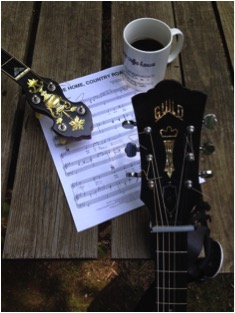
First let’s talk “bridge” in the musical sense. Think of a pop song that goes verse/ chorus, verse/chorus. When that gets too boring, a songwriter will add a bridge: “a contrasting section that prepares for the return to the original material,” according to Wikipedia. Usually the bridge has a significantly different melody so it breaks up the pattern and keeps listeners’ attention, and usually it lasts for eight bars, so it’s sometimes called “the middle eight.” Think of “Take Me Home, Country Roads” by John Denver. There’s a very distinct verse (“Almost heaven, West Virginia …”) and chorus (“Take me home, country roads, to the place I belong …”) pattern that’s interrupted about midway by a very different melody, the bridge (“I hear her voice in the morning hours she calls me. The radio reminds me of my home far away…”) before returning to the chorus to conclude. Essays can do the same thing. Say you’re following a predictable pattern: action/reflection, action/reflection. That can get every bit as dry as verse/chorus, verse/chorus, so a paragraph or three of some kind of “differentness” can add contrast and prepare the readers to return to the original material.
I realized this consciously—though I’d been doing it unconsciously for years—when I was writing an essay called “Grace Behind Glass” about visiting a fish ladder at a dam and admiring the returning salmon. The essay went, essentially: watch the salmon/think about salmon, watch the salmon/think about salmon. That was not terribly interesting, so things were going poorly until I remembered an article I once read about runners in the former Soviet Union, how they gave the author hope for people in oppressive situations everywhere. Just like the salmon! There was my bridge. A bridge can be almost anything: a time leap, an anecdote, a bit of research, or an allusion. In Brenda Miller’s fabulous collection Blessing of the Animals, the bridge is almost always an allusion to a work of visual art. In “Knitted” she’s describing different experiences she’s had with knitting in her life as a way to explore her relationships with her mother and grandmother. Suddenly two thirds of the way in, she swerves off to discuss “The Lacemaker” a painting by Vermeer, before returning to the ending we’ve already anticipated: nowadays she appreciates knitting—and family—in a new way. A bridge works especially well in a one scene essay (the fish ladder essay is a one scene essay.) In Miller’s essay “Naked” she’s watching a naked woman through a gauze curtain. It’s a short essay, just seven paragraphs, but the fifth paragraph is all about photos by Spencer Tunick. Miller takes us for a moment away from the view in the window to a larger perspective before bringing us back. 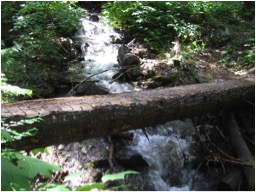
One interesting note about all the art-related “bridges” in Blessing of the Animals is that they create sly cohesion in the collection. Which brings us to the other connotation of bridge, the literal, nonmusical one. For years I worked on trail crews, and we built lots of bridges, many of them simple footlogs. When you’re stuck in an essay and you need to find a way across to the end, consider building a bridge. Sure, you could wade on through, staying with the same ideas, the same pattern. Or you can find some nearby material—it doesn’t have to be fancy—that will suffice. From there, it’s easier than you may think: look for a level spot to set your sills and a level place to land … and go right across.
9. Penultimate Moment (SH)
Earlier I suggested that the shape of an essay forms in my mind long before I start writing it and that my task is to fill in the parts. So what becomes of these shapes in our head? In one of her final interviews, Judith Kitchen said the shape of fiction and nonfiction are very different and that “we should consider how genre affects structure a bit more. We all have a ’shape’ of a [fictional] story in our heads,” she explains, “but often the essay does not have the same kind of ’climax’ and ’closure.’ Instead, it digresses, pushes past its ending into commentary, etc” (31). I think that Judith reflects the majority view here. Unlike fiction which is based on the reader’s expectations, the essay can assume its own shape based on the thinking process of the writer. Such a view is liberating because it allows the essayist to discard conventions for organizing work and leads to greater experimentation in form. To me, one of the most beautiful long meditative essays of our time is The Circus Train by Judith in which she consciously avoided climax and closure, so I take her point.
This view has led to some really self-indulgent and boring experimentation in nonfiction, so I would like to offer a minority view. To me, we take great risks if we think that readers do not bring expectations of form to the nonfiction text, expectations that we blithely discard at our peril. Whether it is a tragedy, a sonata, an epic poem, or a basketball game, the audience expects rising action that leads to a climax, and readers of essays are no different. We can, as Judith does in her book, defy their expectations aware of the resistance we are creating, but we cannot ignore them. I want to suggest, though, that following the conventional path of letting the essay rise to a climax at the penultimate moment—the moment just before the ending—can also be very effective. The expectations in the reader’s mind can coincide with the shape that unfolds on the page, and there is nothing wrong with fulfilling these longings. To illustrate the idea I want to quote the penultimate moment of the essay “The Seam” in the essay collection Potluck by Ana Maria Spagna. The essay is about the way a seam—a healing scar—can form over the divisions between us, a sense of connectedness that is most apt to manifest itself in life and death situations. Here the situation is a plane crash in a lake in which people with very real differences show that they are united at the core. The event could have come at any time in her essay, and chronologically belongs earlier in the piece, but Ana Maria adds intensity to the moving scene by choosing to place it at the penultimate moment, fulfilling our expectations with writing that is vivid, powerful and dramatic. She saves the best, just as we expected, for next-to-last, and, since we had been waiting for this moment all along, we are willing let her slow the clock with lovely, haunting prose, taking us eerily into the fuselage of the downed plane to probe the nightmare at the heart of this essay: They dove. So many of them. They saw the plane upside down and dove. Thirty-eight-degree water, and our friends dove, fully clothed. They performed CPR, some for the first time in their lives, on people they knew and loved, and they did it for two hours, on small boats skimming down the lake racing for civilization and waiting for paramedics to make a determination, even though they already knew. Still, they could not stop. Two bodies. Two boats. Twelve responders. Some people prayed, and some did compressions; others just drove the boats. Why? Why did they do it? Why does anyone do it? Because it’s right or because it’s hard wired in the brain? You do it without a thought: you’re in the cold water, and you’re entering the fuselage, and there they are, the bodies. One still belted upside down, pinned in place, one floating prone, and you can’t get them out, because you are too cold and you need breath, and it’s dark as hell, and for weeks you’ll stay up all night, sleepless, agonizing because you should have done more or you could have done it better, and there is no comfort. All you know is that the edge is still there, the seam where life meets death, and how you behave on that seam is all reflex, and probably a measure of how you behaved the whole time. (172) 10. THE ENDING (AMS)
The no-no’s are familiar. Avoid summary. Avoid the tidy bow. To those I’d add one more, or maybe it’s a clarification, a specification: avoid reflection in the last paragraph. (“Don’t end on the high note,” one writing teacher used to tell me.) Try, instead, a penultimate reflection followed by a grounding scene. But beyond the rules, there’s the feel of a great ending. I hear an ending as a gradually slowing cadence. I experience a good ending like a good airplane landing: not so fast or abrupt that you drop from the sky, not so slow or gradual that you miss the runway.
Doyle’s “Joyas Voladoras” is one of my very favorites. I can hardly read it without weeping. The essay is all about hearts, but here in the last sentence, we finally reach the human heart, and he could’ve used just one example or three, but the long litany creates the gradual slowing cadence that stabs you, yes, in the heart: You can brick up your heart as stout and tight and hard and cold and impregnable as you possibly can and down it comes in an instant, felled by a woman’s second glance, a child’s apple breath, the shatter of glass in the road, the words “I have something to tell you,” a cat with a broken spine dragging itself into the forest to die, the brush of your mother’s papery ancient hand in the thicket of your hair, the memory of your father’s voice early in the morning echoing from the kitchen where he is making pancakes for his children. (30) 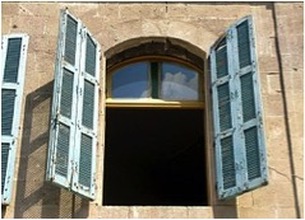
An ending can also repeat an image or object or a line to create resonance. The first essay in my first book Now Go Home, titled “Wilderness, Homelessness and the Crosscut Saw,” is largely a one scene essay about cutting a log out of the trail with a crosscut saw—a very frustrating task—and it ends with the image of a (useless) painted crosscut saw on a restaurant wall: “With one last cup of coffee before I drive, I’ll look up at a crosscut saw mounted above the television at a local diner, a Vermont farmhouse painted over its rusty teeth. From where I sit, it will look exactly like hope.”
In hindsight, I see that ending as a tad too tidy (I was new to the craft, and I can’t go back and revise now, one of the challenges/joys of endings in nonfiction.) It’s more effective, I think, to open things back up and speculate about the future. At the end of Steve’s essay “The Old Surprises” he also repeats a line from the very opening of the essay: “Matt, Come see.” In the beginning, he was waking his son asleep in his tent to see the planets in alignment in the night sky. In the last paragraph he moves into future tense to imagine what may happen someday. It’s the subjunctive wrapped in the language of certainty, and I’ll end with it: Tics by the pencil sharpener in the hall mark Matt’s growth to my height and away from me. He may always see in the mirror a cloudy image of all the old men in his sky, and become them as he becomes himself, but he will soon leave me behind and enter a world that is increasingly his, a world in which he will never be his own man except as I find it harder and harder to recognize myself in him. “Matt,” I will say one of those days, collapsing the generations in my delirious dream of stars in line and geese flying low across the evening sky. “Matt, come see!” The stranger by my bedside will lift his head in grief and be my son. (85) |
Note: “The Essay in Parts” is based on a presentation that Steven Harvey and Ana Maria Spagna gave at the annual River Teeth Nonfiction Conference on Saturday, May 30, 2015. Click here for the video.
Click here to download a printable PDF with Works Cited.
|
Steven Harvey is the author of The Book of Knowledge and Wonder, a memoir published by Ovenbird Books as part of the “Judith Kitchen Select” series. A section of the memoir appeared in The Best American Essays 2013 selected by Cheryl Strayed. He is also the author of three books of personal essays. A Geometry of Lilies, Lost in Translation, and Bound for Shady Grove and edited an anthology of essays written by men on middle age called In a Dark Wood. He is a professor emeritus of English and creative writing at Young Harris College, a founding member of the nonfiction faculty in the Ashland University MFA program in creative writing, a senior editor for River Teeth magazine, and the creator of The Humble Essayist, a website designed to promote literary nonfiction. You can learn more about Steve and his work at his author web site.
|
Ana Maria Spagna lives and writes in Stehekin, Washington, a remote community in the North Cascades. She’s the author of the memoir/history, Test Ride on the Sunnyland Bus, winner of the River Teeth literary nonfiction prize, two essay collections, Potluck and Now Go Home, and the forthcoming Reclaimers, a narrative triptych. She has twice been a finalist for the Washington State Book Award, and her essays appear regularly in journals and magazines such as Orion, Creative Nonfiction, Brevity, North American Review, and Ecotone. After working many years on backcountry trail crews, she now teaches nonfiction and serves as Assistant MFA Program Director for Whidbey Writers Workshop at Northwest Institute of Literary Arts.
Related Works
|
Kelly Harwood
Then and Now: A Study of Time Control in Scott Russell Sanders' "Under the Influence" 1.2 Articles |
Diana Wilson
Laces in the Corset: Structures of Poetry and Prose that Bind the Lyric Essay 1.2 Articles |
